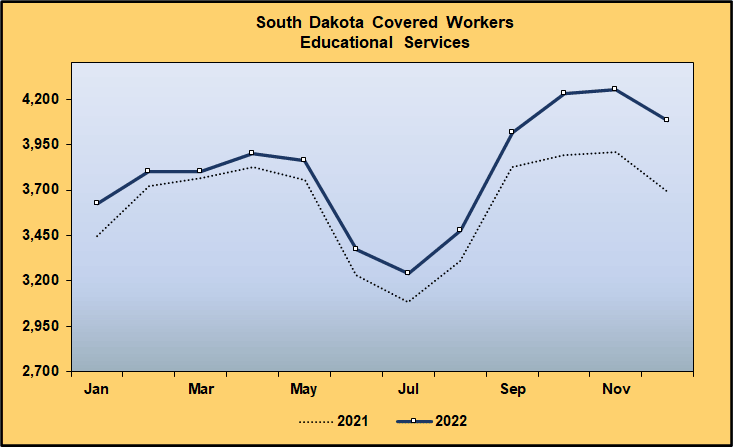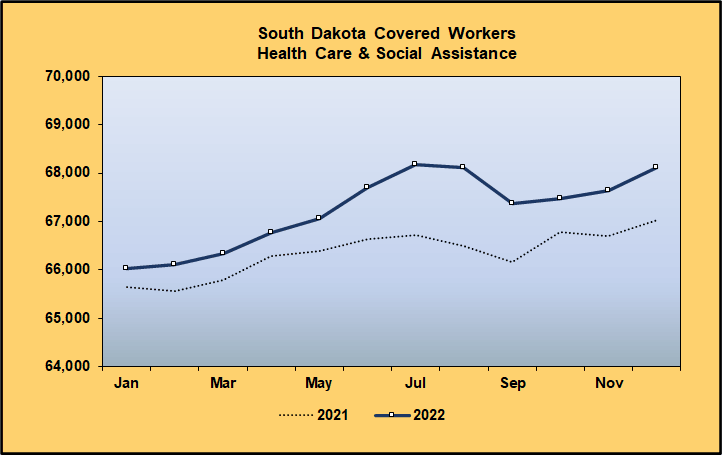- Home to LMIC
- Virtual Labor Market Data System
- Career Exploration & Planning
- Consumer Price Index
- Demographics
- Economic Snapshot
- Employee Benefits
- Employment Projections
- Labor Force & Unemployment
- Labor Supply
- Overview of the Current Labor Market
- Surveys We Conduct
- Wages & Income
- Workers by Industry
- Tools & Resources
- Publications
- References
- What's New
- Can't Find It?
Labor Market Information Center
2022 Annual Report
Quarterly Census of Employment and Wages
Education and Health Services Supersector
The Education and Health Services supersector is comprised of the Education Services sector and the Health Services and Social Assistance sector. Businesses within this supersector provide instruction and training or provide health care and social assistance to individuals.
| South Dakota Covered Workers and Pay 2022 |
|||
| Supersector, Sector and Subsector | Number of Establishments | Average Number of Workers | Annual Pay |
| Education and Health Services | 3,394 | 71,045 | $61,521 |
| Educational Services | 516 | 3,808 | $33,341 |
| Educational Services | 516 | 3,808 | $33,341 |
| Health Care and Social Assistance | 2,878 | 67,237 | $63,117 |
| Ambulatory Health Care Services | 1,732 | 19,282 | $83,660 |
| Hospitals | 68 | 27,908 | $69,566 |
| Nursing and Residential Care Facilities | 346 | 11,741 | $36,716 |
| Social Assistance | 732 | 8,307 | $31,071 |
| Totals may not add due to rounding. Data subject to revision. Produced by the Labor Market Information Center, South Dakota Department of Labor and Regulation, in cooperation with the U.S. Bureau of Labor Statistics. |
|||
Educational Services
NAICS Sector 61
In 2022, the private Educational Services sector gained 184 workers (5.1%). The employment level was 3,808. The annual wage increased $1,330 (4.2%) from 2021 to 2022 to a new average of $33,341.
The Educational Services sector is made up of establishments providing instruction and training in a wide variety of subjects. This instruction and training is provided by specialized establishments, such as schools, colleges, universities and training centers. Educational services are usually delivered by teachers or instructors who explain, demonstrate, supervise and direct learning. Instruction is imparted in diverse settings, such as educational institutions, workplaces or even homes and through diverse means, such as correspondence, television, the internet or other electronic and distance learning methods.
The training provided by these establishments may include the use of simulators and simulation methods. It can be adapted to the needs of the students, for example sign language can replace verbal language for teaching students with hearing impairments. All industries in the sector share this commonality of process, namely, labor inputs of instructors with the requisite subject matter expertise and teaching ability. These establishments may also offer food and accommodation services to their students.
Educational Services is comprised of only one subsector. Within the subsector are the following industry groups:
- Elementary and Secondary Schools (NAICS 6111)
- Junior Colleges (NAICS 6112)
- Colleges and Universities (NAICS 6113)
- Business, Computer, and Management Training (NAICS 6114)
- Technical and Trade Schools (NAICS 6115)
- Other Schools and Instruction (NAICS 6116)
- Educational Support Services (NAICS 6117)
The largest employment gains occurred in Elementary and Secondary Schools, Colleges, Universities, and Professional Schools, Other Schools and Instruction and Educational Support Services. The remaining industry groups saw no significant change to employment levels in 2022.
Establishments in the Colleges, Universities, and Professional Schools industry group are primarily engaged in furnishing academic courses and granting degrees at baccalaureate or graduate levels. It is the largest industry group, responsible for about 50% of employment in the sector, mostly because the industry contains the largest privately owned colleges in South Dakota. Other professional schools (e.g., business administration, dental, law, medical) are also included.
The Educational Services sector is widely considered counter-cyclical. Typically, when the economy is doing well and unemployment is low, more working adults decide to go to work. More career and job prospects available for working adults, in turn, leads to lower enrollment, decreased profit and a lower need for teachers/instructors at schools. Conversely, when the economy is doing poorly, unemployment is rising, and career opportunities start to dim, working adults are more likely to upgrade their education and skills. This can lead to higher enrollment and increased profits for establishments providing educational services.
Establishments in this sector are privately owned and operated for profit or not for profit. Publicly owned establishments, usually owned and operated by state and local governments, are not included in this analysis. Statistics for those types of establishments are analyzed under the Public Administration supersector. Roughly 10% of the employment in Education falls in privately owned establishments, with the rest being in publicly owned establishments.

Health Care and Social Assistance
NAICS Sector 62
The Health Care and Social Assistance sector grew once again in 2022. Both employment and wages increased from 2021. Compared to other sectors, this sector has the highest level of employment and largest amount of total wages paid out in South Dakota.
The number of workers reached 67,237, growing 1.3% from 2021. Average annual wages increased $2,800 (4.6%) to $63,117. This sector includes both health care and social assistance, because sometimes it is difficult to distinguish between the boundaries of these two activities. The Health Care and Social Assistance sector is made up of four subsectors.
- Ambulatory Health Care Services (NAICS 621)
- Hospitals (NAICS 622)
- Nursing and Residential Care Facilities (NAICS 623)
- Social Assistance (NAICS 624)
The Ambulatory Health Care Services subsector’s employment grew 3.5% to 19,282 in 2022. The annual average wage was $83,660, which is the highest of all four subsectors. These establishments provide health care services directly or indirectly to ambulatory patients and do not usually provide inpatient services. Employment gains were distributed evenly through most of the industry groups. The largest employment gains, percentage wise, were seen in Outpatient Care Centers and Other Ambulatory Health Care Services.
The Hospitals subsector is comprised of establishments providing medical, diagnostic and treatment services that include physician, nursing and other health services to inpatients and the specialized accommodation services required by inpatients. Hospitals may also provide outpatient services as a secondary activity. These establishments provide inpatient health services, many of which can only be provided using the specialized facilities and equipment that form a significant and integral part of the production process.
Some of the largest establishments in South Dakota belong to the Hospitals subsector. The number of workers in 2022 increased by 1.3% to 27,908. This subsector’s average annual wage increased $4,088 (6.2%) to $69,566.
The Nursing and Residential Care Facilities subsector saw employment decrease in 2022. Following the trend since late 2019, worker levels went down 1.6% to 11,741. The annual average wage grew 9.1% to $36,716. This subsector’s establishments provide residential care combined with either nursing, supervisory or other types of care as required by the residents. Examples of facilities included in this subsector are nursing homes which have a permanent core staff of nurses along with other staff to provide nursing and continuous personal care services. Assisted and unassisted continuing care retirement community facilities are also part of this industry. Some of the residents need some nursing and personal care while others need limited services because they do not desire to live independently, so nursing care is not as vital. Care typically includes room, board, supervision and assistance in daily living, such as housekeeping services. Although the demand for this type of care is high in South Dakota, establishments struggle to find and keep workers in this subsector.
The Social Assistance subsector’s employment level increased by 68 workers (0.8%) to 8,307. Establishments provide a wide variety of social assistance services directly to clients. Vocational rehabilitation services belong to this subsector. Business activities include providing job counseling, job training and employment for persons with disabilities. Most of the gain in 2022 can be attributed to Community Food and Housing and Vocational Rehabilitation Services industry groups. Employment levels in the Child Care Services industry group decreased slightly in 2022, after a large increase in 2021.

